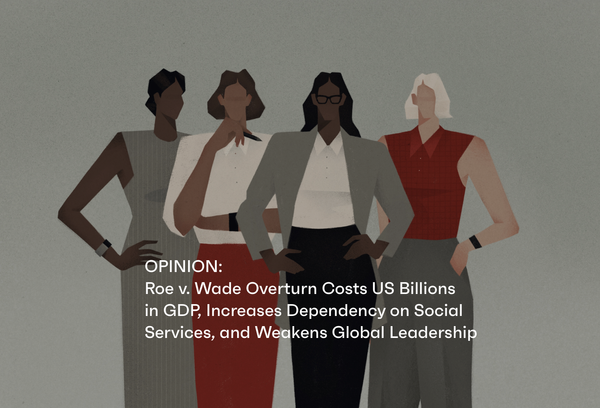This week marks the 51st anniversary of Roe v. Wade and 19 months since its reversal. We're observing significant impacts across the nation, and it's crucial to consider what lies ahead if we don't secure reproductive rights at the federal level.
Outcomes Over the Last 19 Months
- OBGYNs are relocating to states where their services remain legal, creating "maternity care deserts." This migration is diminishing access to essential reproductive healthcare, especially in regions where it was already scarce.
- We're in the midst of an escalating maternity care crisis. Black women face a childbirth mortality rate 3 times higher than that of white women, and this disparity is likely to increase. In 2021, roughly 33 people died for every 100,000 live births in the U.S., according to the CDC, up 40% from 2020. That’s roughly 10 times the mortality rate of other industrialized nations such as Spain, Germany, Australia or Japan.
Despite anti-abortion advocates citing the need to prioritize life and country prosperity, these measures might lead to the opposite effect.
What can we expect if access to abortion is not secured on a federal level?
Foregoing a Potential $511 Billion Boost to the US GDP
Research indicates that access to abortion significantly impacts women's lives, especially regarding when and under what conditions they become mothers, their educational and workforce participation, and their earnings.
Specifically, unwanted pregnancies can hinder women's ability to join the workforce. It's crucial to note that the increasing rate of female participation in the U.S. workforce has been a major driver of the country's economic prosperity since the Roe v. Wade decision 51 years ago. In the 1950s, only 1 in 3 women (33.9%) participated in the labor force. By 2019, this number had nearly doubled, reaching 57.4%, positioning women as a cornerstone of the American economy.
S&P Global's analysis suggests that a modest increase in women's workforce participation in the U.S. could add $511 billion to the GDP over the next ten years. This growth, stemming from increased women’s labor participation, could translate into trillions of dollars in added equity market value. For instance, the U.S. could see an additional $4.5 trillion in market value over the next decade.
Conversely, restricting reproductive freedom could lead to lower educational attainment and reduced labor force participation among women. This would miss out on potential GDP and innovation growth and affect the country's overall economic health.
Historically, women's participation in the U.S. labor force has significantly influenced economic growth. During the Great Recession (2007-2009), for example, increased labor force participation, including that of women, was vital for economic recovery and growth in the subsequent years.
Increasing Burden on Future Generations' Social Security
In addition to missing opportunities for economic growth, further economic setbacks are evident. A 2023 report shows that in the U.S., states with abortion restrictions or bans tend to have lower wages, weaker labor standards, and higher incarceration rates compared to states with abortion protections.
The lack of reproductive choice significantly impacts those at or below the federal poverty level — accounting for half of all abortion patients (Jones and Jerman 2017). This restriction not only reduces women's earnings but also increases their reliance on government support. Predominantly affecting black and low-income populations, this issue exacerbates the formation of families in uneducated and low-income communities, adversely affecting the next generation. Births in populations lacking adequate healthcare or financial stability lead to increased healthcare and social service costs for the next generation. These escalating costs can overburden public resources and significantly impact state budgets.
Conclusion
Abortion is often seen as a personal or religious matter, yet it fundamentally serves as a critical economic factor with the potential to influence the economy significantly. Revoking reproductive rights can have a lasting impact on the economic stability of numerous individuals across generations and the economy of the entire country. With the world facing instability, securing reproductive rights on a federal level for both men and women in America is crucial. This step is directly tied to our economic prosperity and is key to strengthening our nation globally, something that's so critically important right now.
Lastly, I'd like to share something personal
I grew up with a single mother on a low income. When I was 7, my mother had to make the difficult decision to terminate an unwanted pregnancy. This decision was not made lightly, but it allowed her to use our very scarce resources to invest in my education. As a result, I became the first person in our family to earn a college degree and speak English, and started Stork Club, which has helped many people build their families and provided job opportunities in the US, creating financial and healthcare security for numerous families. I firmly believe that by supporting reproductive freedom for everyone, we can make our country greater.

Appendix or did you know?
On average, states with abortion restrictions or total bans have (Banerjee , 2023):
- lower minimum wages ($8.17 compared with $11.92 in the abortion-protected states)
- unionization levels half as high as the abortion-protected states
- only 3 in 10 unemployed people receive unemployment insurance (compared with 42% in other states)
- lower rates of Medicaid expansion
- an incarceration rate 1.5 times that of the states with abortion protections
Free access to abortion show:
- reduced the number of women who became teen mothers by 34% (Myers, 2017)
- reduced maternal mortality among Black women by 30-40% (Hoehn-Velasco, Pesko 2021)
- reduced cases of child neglect and abuse (Bitler and Zavodny, 2002b; 2004)
- reduced the number of children who lived in poverty (Gruber, Levine, and Staiger, 1999)
- improved long-run outcomes of an entire generation of children by increasing the likelihood of attending college and reducing the likelihood of living in poverty and receiving public assistance (Ananat, Gruber, Levine, and Staiger, 2009)





